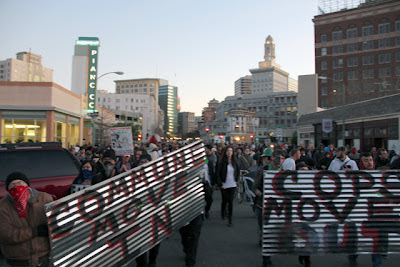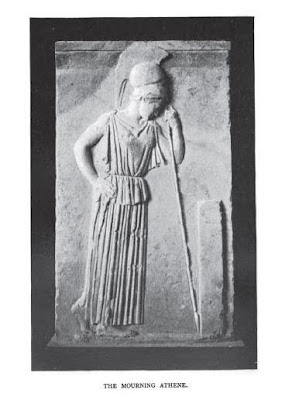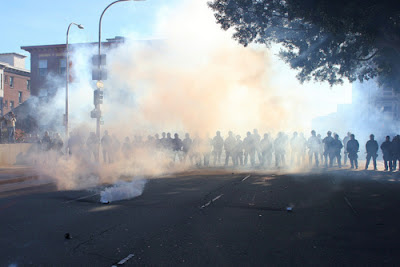

In Oakland, a significant minority of activists do not consider these men to be sacred relics of Nonviolent Resistance to be worshiped as if Divine. How rude! Indeed, when one man stood up at an Occupy Oakland General Assembly and denounced Gandhi in no uncertain terms (which I will not repeat because the terms were so rude... eek) it caused a minor firestorm among the multitude. How dare he!? Well, he did, and it had the effect of breaking a kind of spell that is cast on Americans with the mention of Mahatma Gandhi or Martin Luther King, Jr.
A spell that has proved very useful tamping down and keeping at bay any effective resistance to the triumph of America's real class warriors for decades on end.
"Gandhi wouldn't do that!" "Martin Luther King would be embarrassed to hear you say that!"
Be like Gandhi and King! That's the only way to win!
Gandhi led campaigns for simple justice in South Africa and Independence from the British Raj for India from the 1890's until his unfortunate assassination in 1948. King led campaigns for basic civil rights, justice and dignity for African Americans in the United States from the 1950's to his unfortunate assassination in 1968.
Gandhi failed to win his campaign for simple justice in South Africa; that would not come for generations under other leadership, and some would say it hasn't arrived yet. He ultimately saw victory in his campaign to free India from British rule, but not his dream of a free India. When he was shot and killed, India was still in the throes of assembling itself into a nation, a very bloody and dispiriting process as it happened.
King lived to see the "mountaintop" as he called it, but he did not get to the "Promised Land" before a rifleman's caught up to him in Memphis. For the "Promised Land" wasn't just the right to vote and to sit at a lunch counter in the South, far from it. He was in Memphis to press for economic justice for garbage men, and since the success of the Civil Rights Movement, he'd been pressing more and more insistently to end the War in Vietnam, and to raise up Americans of all colors from poverty and economic despair. He would not live to see either goal accomplished, nor can Americans today see any end to global warfare against... something... and every year since the Endless Recession began the poverty rate goes up; it's higher now than it was in 1968. (12.8% in 1968 vs 15.1% in 2011.)
Both Gandhi and King are rightly praised and celebrated for their triumphs and for their similar approach to their struggles. Both got partway to their goals before they were killed. Though their legacies live on -- and have had astonishing results a generation or two after their deaths -- it's not at all clear that conditions now, in India or the United States, would please them. There has been much backsliding or sidestepping. Progress in the United States seemed to halt sometime around 1982; in India, the material record may be somewhat better, but what of the spirit that was so essential to Gandhi -- and King for that matter?
We have come so far, yet we have so far to go.
And it is widely claimed that the only way forward is on the nonviolent paths laid for us by Mahatma Gandhi and Martin Luther King. Anything else leads to madness, suffering, and failure.
What is nonviolence?
I argue that nonviolent tactics are weapons. When well employed, they can be extraordinarily effective. But Americans seem to have lost sight of what nonviolent tactics are, often confusing them with passivity, and too few have any idea how to use them effectively let alone who they should be used against and why.
Gandhi and King had very profound insights into the nature of their struggles and the nature of nonviolence in the context of their struggles, and I feel confident in saying that insight was a direct result of their essentially "holy" status.
Gandhi may have been a lawyer -- there's nothing particularly "holy" about that! -- but he was informed by his extraordinary spiritual life that kept him personally centered and free no matter what was going on around him -- which included some of the most dreadful and poignant events in the history of India. We forget that the British were almost inconceivably cruel in their rule of India using famine, genocide, murder, dispossession, bribery and immense levels of brutality to control the restive Natives. What the British did to the Indians makes their impositions on the American Colonists that led to the Revolution seem like a walk in the park.
And all of Britain's heavy handed atrocities were utilized in suppressing the Indian self-determination and self-rule during Gandhi's decades long campaign for Independence.
The struggle wasn't solely a against British cruelty and violence toward their dusky charges. No, half the sub-continent was ill-ruled through native Maharajahs who functioned as British lackeys almost to the very end. They were paid handsomely for their service in suppressing the native revolts, and if they didn't suppress revolts smartly enough, they were deposed... so what did they have to complain about?
In contrast to this routine violence on the part of the British and their client rulers, Gandhi's struggle was conducted through a process of nonviolent resistance, the sharpest weapon available to his largely impoverished followers under the circumstances. Of course using it meant much sacrifice on the part of the Indian masses, sacrifice which Gandhi himself was ever cognizant of and frequently recognized through word and deed. Many thousands of Indians paid for independence from Britain with their lives; and if you add in the famine casualties, the death toll was in the millions.
Throughout Gandhi's nonviolent campaigns there were parallel campaigns against the British that utilized violent tactics like kidnapping, sabotage, murder and other forms of violence as well as frequent civil disturbances. Never let it be forgotten that Gandhian nonviolent campaigns were taking place in a context that was sometimes extraordinarily violent.
It was partly because of that contrast the nonviolent campaigns of Gandhi and his followers and the violence of some other Indian rebel factions that the British essentially adopted Gandhi as the one spokesperson for India that they would deal with. So many of the other Natives were just too eager to slit British throats. Which they cheerfully did any chance they got.
But Gandhi was wise enough to use nonviolence as a weapon, too. One that in the end proved more effective than all the murders, kidnappings, sabotage and worse that were taking place while his nonviolent campaigns were going on.
For through nonviolence, Gandhi was able to shame on British, as they had never felt shame before, for their intolerable Imperial conduct.
Of course there was more to the victory of the Independence campaign than merely shaming the British or conducting nonviolent demonstrations. After the horrors and destruction of World War II, no European power could afford an overseas Empire any more. Better to cut one's losses while one could than to try to continue to assert power that wasn't viable -- or affordable -- any more. So the Brits finally packed up and left, India and Pakistan descended into chaos for a while, and India re-emerged -- without Gandhi -- as if it were a phoenix rising. From that day till this, it has been a hard road, but a nonstop march forward, resulting today in an India that I doubt Gandhi could have imagined.
Nonviolence was the weapon that eventually won Indian freedom from British rapine and rule, but it took decades of relentless driving home the point. I believe Gandhi started his campaign in India in 1915. It would be over thirty years -- and two world wars -- before British rule ended.
The British Raj in India and its client states (the Princely States) were effectively ruled by approximately 1000 British civil servants under the authority of the Viceroy on behalf of the Crown 8000 miles away in London. There were of course thousands more British civilians and military officers in India during the period of the British Raj, but their number was always vastly fewer than that of the Indian People. The intrinsic injustice of the situation could not be avoided, and Gandhi took full advantage of it. Because there were so few British ruling over so many Indians, finding the weak spots and using the weapon of nonviolence to expose the shame of its injustice to Indians and the world helped destabilize the whole system -- until by 1947, it collapsed and the British Raj came to an ignominious end.
That's quite a different situation than Martin Luther King faced in shepherding the Civil Rights Movement primarily in the American South. The goal was something else entirely: the inclusion of Negroes in the American social, political and economic system as opposed to their continued segregation and exclusion. Whereas Gandhi was focused on getting the British to quit India, King had the task of focusing America -- particularly in the South -- on including all of its people instead of segregating and excluding a significant minority of them.
In most of the South, Blacks were not the majority of the population. Segregation and Black disempowerment was the custom after the end of Reconstruction. White rule was considered natural. Thanks to the legacy of slavery and Jim Crow, there was a very limited educated and well-off Black population. The customs of the South tended to keep it that way.
The struggle against Black oppression was not new when Martin Luther King founded the SCLC. It was not new when the Little Rock Nine integrated Central High School in Little Rock, AR with the assistance of the 101st Airborne. It was not new when Rosa Parks disobeyed a Montgomery, AL, bus driver. It was not new when Emmett Till was lynched outside of Money, MS. It was not new when the Supreme Court decided Brown vs Board of Education. It was not new when the black Navy munitions loaders mutinied at Port Chicago, CA after an explosion that killed over 300 of their number. The struggle against Black oppression was not new when the Scottsboro Boys were falsely accused, nor was it new when the white citizens of Tulsa went on a riotous rampage through the colored section of town killing over 300, leaving over 10,000 homeless, and burning the entire district.
It was not new when Paul Laurence Dunbar wrote his Poems. It was not new when W.E.B. DuBois and others formulated the Niagara Declaration.
The struggle against Black oppression had been going on in one way or another in the United States since Colonial times, and it continues to this day.
The goals of the Civil Rights Movement were to empower Blacks politically and socially and to end segregation laws. There was no thought of removing the government and substituting another. It was not, in other words, a Revolution, nor was it an Independence movement. It was about realizing the equality promise of the Declaration and Constitution and beginning the process of redemption from the original sin of chattel slavery.
Nonviolence patterned after Gandhi's model was the chosen path of Dr. King and the SCLC.
The nonviolent program of the Dr. King nevertheless still led to dozens of deaths of civil rights workers through the 1950's and into the 1960's. As Frederick Douglass said, "Power concedes nothing without a demand." And in the early days of the civil rights struggle, it was apparent that Power wasn't about to concede anything, demand or no.
But the Montgomery Bus Boycott and the shame brought on the South from the Emmett Till murder and the violent resistance to school integration showed that Power in the South was very brittle, and thus in many ways weak.
There were ways, nonviolent ways, to alter the power relationships that were thought to be permanently designed by God Himself. And so, from 1955 to 1965 an increasingly disciplined and visible Civil Rights Movement took to the streets of many cities in the South as well as the North to advocate for Civil Rights and Constitutional protections for everyone. There were hundreds of marches, sit ins, teach ins, and acts of civil disobedience, some of them met with extreme violence and brutality by the authorities, other not so much; there were rallies and assemblies and voter registration drives. Dozens of people were killed, hundreds or thousands were injured or arrested and jailed, but bit by bit the restrictions and impediments of segregation were rolled back, to the point where, by 1965, Blacks had restored to them almost the level of rights and protections they had enjoyed after the Civil War in 1865. That's a bit of hyperbole, but the success of the Civil Rights Movement was almost a restoration of Reconstruction rights.
King and his followers used nonviolence tactics as weapons to undermine the authority of the iconic "big bellied Southern Sheriffs," and this in turn helped more and more Americans in general to understand just what a monstrous evil the Southern Jim Crow segregation laws and restrictions on basic civil rights were. That realization and the overt and constant brutality of the oppression of the Civil Rights Movement eventually helped change the laws.
But none of this happened in a vacuum. The nonviolent Civil Rights Movement that Dr. King led was paralleled by many other individuals and groups fighting for civil rights in America, some of them a good deal more militant. There was the Nation of Islam, Malcolm X, Black Panthers, Student Nonviolent Coordinating Committee and many others, each with a different interpretation of nonviolent resistance and its utility in the struggle against oppression.
But let it be said that nearly all the violence that was perpetrated during the Civil Rights struggle up to 1965 was perpetrated by whites under color of authority -- or otherwise -- against Blacks and other civil rights workers.
Nonviolent tactics were successfully used as weapons in the struggle against oppression in both India and the United States. They were used to weaken and expose the very brittle structures of Power in the British Raj and in the American South, and they were used to bring shame on the perpetrators of violence against nonviolent demonstrations, protests and rallies.
Laws were changed in the United States and changed attitudes eventually followed. The British Empire eventually dissolved as if it had never been.
India achieved independence in 1947; Gandhi was assassinated in 1948; the crucial Civil Rights Act was passed in 1964, and the Voting Rights Act was passed in 1965. Martin Luther King was assassinated in 1968, by which time almost all segregation and racial discrimination laws had been overturned, though Americans are still not at the point of full equality.
Nonviolence tactics worked and worked very well to accomplish specific goals that were set -- though they took a long time to become effective -- under the circumstances.
There were many lessons learned from the experience, and among the questions we ought to be asking now are "What were those lessons, and what exactly was learned? By whom?"
Next: The Lessons of Nonviolent Resistance and Who They Benefit



